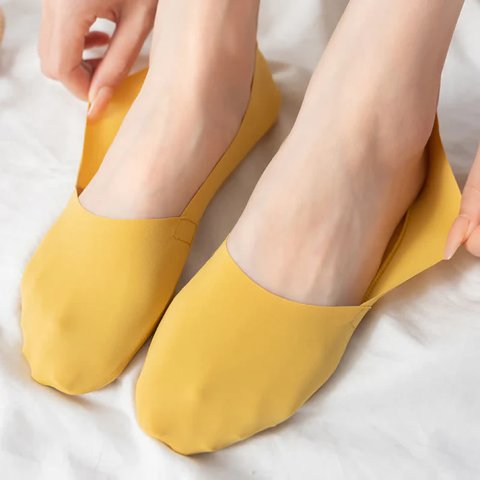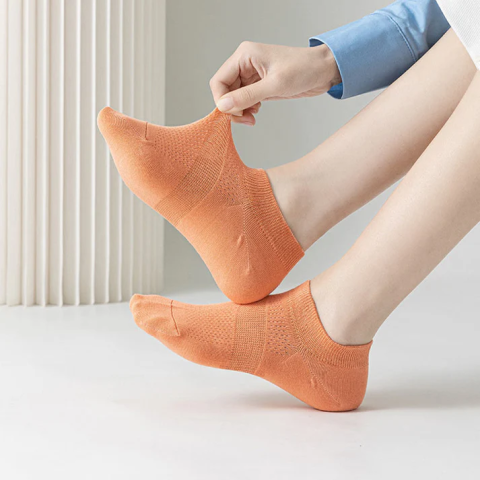Summer is getting closer and closer. People are dressing in cooler styles. Bamboo clothing has become a favorite. For example, bamboo sheets and socks. But at the same time, breathable and comfortable cotton socks are also popular. Especially no-show socks. In this article, we will compare the difference between the two and give you our opinion.

Bamboo Socks vs. Cotton Socks
Bamboo fiber socks and cotton socks offer distinct advantages. Let's compare the features of each to see which one stands out as the superior choice for everyday wear.
Comfort
Bamboo fiber socks: typically have a higher softness score, which is attributed to the natural structure of bamboo fibers, whose microscopic form provides a more delicate touch. Bamboo fibers also have a higher elasticity index, which means they provide a better fit and natural stretch during activity.Cotton socks: As far as softness is concerned, high-quality cotton socks are very soft and comfortable and retain their softness after a few washes. And the comfort and breathability of cotton has always been very popular among users. Such as plus size socks. However, regular cotton is not as elastic as bamboo fiber and may loosen up after a long time of wearing.

Breathability and moisture-wicking
Bamboo socks: Studies have shown that bamboo fibers can absorb and evaporate more than three times their weight in sweat produced by the human body, a property that makes bamboo socks perform well in high temperatures or high-intensity activities.
Cotton socks: Cotton socks are better at absorbing moisture, but in higher humidity environments, the cotton material does not absorb water quickly enough to evaporate, which may cause the socks to feel cold and uncomfortable.
Antibacterial
Bamboo fiber socks: Some studies have shown that bamboo fibers are naturally antibacterial and antimicrobial, and maintain a certain level of antimicrobial properties even after multiple washes, which helps to reduce odor and improve hygiene.
Cotton socks: Cotton material does not have natural antimicrobial properties on its own and therefore needs to be washed routinely to maintain hygiene. Antimicrobial-treated cotton socks are also available on the market, but this feature may diminish with more frequent washing.
Durability
Bamboo fiber socks vs. cotton socks: durability depends a lot on how the socks are made and how the fibers are treated. Although bamboo fiber socks excel in softness and breathability, they may not be as durable as specifically processed cotton socks under intense friction and frequent washing. Cotton socks with high density knitting may be more durable.
Eco-Friendliness
Bamboo fiber socks: Bamboo grows quickly and does not require large amounts of pesticides or fertilizers, making its production process more environmentally friendly. However, chemicals may be used in the processing of bamboo into fibers, so environmental friendliness also depends on the specific methods of the production process.
Cotton socks: Conventional cotton cultivation consumes large amounts of water and uses chemical pesticides, but the development oforganic cotton and sustainable production methods offers ways to reduce the environmental impact of cotton sock production.
Price
Bamboo fiber socks vs. cotton socks: The price difference is largely determined by brand, design complexity, and production costs. Although bamboo fiber socks are typically more expensive, their unique properties and environmental benefits may be valued by some consumers.
Style and Color Options
Bamboo socks and cotton socks: With technological advances, socks made of both materials are now available in a wide range of styles and color options. While the market for cotton socks is more mature with a wide range of styles, bamboo fiber socks are becoming more diverse in design to meet the needs of different consumers.
Aspect Bamboo Fiber Socks Cotton Socks
Comfort Softer with better fit due to elasticity. Soft, less elastic, retains softness.
Breathability & Moisture-Wicking Superior absorption and evaporation. Good absorption, less quick to dry.
Antibacterial Properties Natural antibacterial qualities. Requires washing or treatment for hygiene.
Durability Less durable under stress and wash. More durable, especially with dense knitting.
Eco-Friendliness Environmentally friendly, method-dependent. Higher water and pesticide use, except organic.
Price More expensive, reflects unique benefits. Varies, influenced by brand and design.
Style and Color Options Increasingly diverse designs. Wide range, mature market.
When choosing between bamboo fiber socks or cotton socks, it is crucial to consider the specific needs of the individual, the type of activity, and the importance of being environmentally friendly. It is also important to consider the long-term cost of use and ease of maintenance. Each material has unique benefits and limitations, and understanding these differences can help consumers make a choice that better meets their needs.
Where to Find Quality Socks
Finding quality socks involves considering the material, craftsmanship, and the specific needs you have, such as for sports, daily wear, or medical conditions. Here are some places and ways to find high-quality socks:Specialty Sock Stores: Specialty sock stores may offer a variety of high-quality options for different activities such as hiking, running, or formal wear. Plusock, for example, specializes in plus size compression socks as well as regular socks.
Online Retailers: Websites such as Amazon and Zappos offer a wide variety of socks. Look for products that are highly rated by customers and mention longevity, comfort, and material quality in your reviews.Brand Websites: Visit the websites of well-known brands directly to access their entire product catalogs, often including web exclusives; brands such as Bombas, Smartwool, Darn Tough, and Thorlo are known for their high-quality socks.
Outdoor and Sporting Goods Stores: If you need socks for specific activities such as skiing, hiking, or running, stores such as REI, Dick's Sporting Goods, and Decathlon have socks designed for these activities.
In conclusion, the evaluation of bamboo fiber socks against traditional cotton counterparts highlights a clear advantage in foot health and comfort. With superior moisture-wicking capabilities and inherent antimicrobial properties, bamboo fiber socks emerge as a holistic solution. As we stride forward, it's evident that bamboo fiber socks stand as a testament to innovation in enhancing our everyday comfort and well-being.
Bamboo Socks vs. Cotton Socks
Bamboo fiber socks and cotton socks offer distinct advantages. Let's compare the features of each to see which one stands out as the superior choice for everyday wear.
Comfort
Bamboo fiber socks: typically have a higher softness score, which is attributed to the natural structure of bamboo fibers, whose microscopic form provides a more delicate touch. Bamboo fibers also have a higher elasticity index, which means they provide a better fit and natural stretch during activity.Cotton socks: As far as softness is concerned, high-quality cotton socks are very soft and comfortable and retain their softness after a few washes. And the comfort and breathability of cotton has always been very popular among users. Such as plus size socks. However, regular cotton is not as elastic as bamboo fiber and may loosen up after a long time of wearing.
Breathability and moisture-wicking
Bamboo socks: Studies have shown that bamboo fibers can absorb and evaporate more than three times their weight in sweat produced by the human body, a property that makes bamboo socks perform well in high temperatures or high-intensity activities.
Cotton socks: Cotton socks are better at absorbing moisture, but in higher humidity environments, the cotton material does not absorb water quickly enough to evaporate, which may cause the socks to feel cold and uncomfortable.
Antibacterial
Bamboo fiber socks: Some studies have shown that bamboo fibers are naturally antibacterial and antimicrobial, and maintain a certain level of antimicrobial properties even after multiple washes, which helps to reduce odor and improve hygiene.
Cotton socks: Cotton material does not have natural antimicrobial properties on its own and therefore needs to be washed routinely to maintain hygiene. Antimicrobial-treated cotton socks are also available on the market, but this feature may diminish with more frequent washing.
Durability
Bamboo fiber socks vs. cotton socks: durability depends a lot on how the socks are made and how the fibers are treated. Although bamboo fiber socks excel in softness and breathability, they may not be as durable as specifically processed cotton socks under intense friction and frequent washing. Cotton socks with high density knitting may be more durable.
Eco-Friendliness
Bamboo fiber socks: Bamboo grows quickly and does not require large amounts of pesticides or fertilizers, making its production process more environmentally friendly. However, chemicals may be used in the processing of bamboo into fibers, so environmental friendliness also depends on the specific methods of the production process.
Cotton socks: Conventional cotton cultivation consumes large amounts of water and uses chemical pesticides, but the development oforganic cotton and sustainable production methods offers ways to reduce the environmental impact of cotton sock production.
Price
Bamboo fiber socks vs. cotton socks: The price difference is largely determined by brand, design complexity, and production costs. Although bamboo fiber socks are typically more expensive, their unique properties and environmental benefits may be valued by some consumers.
Style and Color Options
Bamboo socks and cotton socks: With technological advances, socks made of both materials are now available in a wide range of styles and color options. While the market for cotton socks is more mature with a wide range of styles, bamboo fiber socks are becoming more diverse in design to meet the needs of different consumers.
Aspect Bamboo Fiber Socks Cotton Socks
Comfort Softer with better fit due to elasticity. Soft, less elastic, retains softness.
Breathability & Moisture-Wicking Superior absorption and evaporation. Good absorption, less quick to dry.
Antibacterial Properties Natural antibacterial qualities. Requires washing or treatment for hygiene.
Durability Less durable under stress and wash. More durable, especially with dense knitting.
Eco-Friendliness Environmentally friendly, method-dependent. Higher water and pesticide use, except organic.
Price More expensive, reflects unique benefits. Varies, influenced by brand and design.
Style and Color Options Increasingly diverse designs. Wide range, mature market.
When choosing between bamboo fiber socks or cotton socks, it is crucial to consider the specific needs of the individual, the type of activity, and the importance of being environmentally friendly. It is also important to consider the long-term cost of use and ease of maintenance. Each material has unique benefits and limitations, and understanding these differences can help consumers make a choice that better meets their needs.
Where to Find Quality Socks
Finding quality socks involves considering the material, craftsmanship, and the specific needs you have, such as for sports, daily wear, or medical conditions. Here are some places and ways to find high-quality socks:Specialty Sock Stores: Specialty sock stores may offer a variety of high-quality options for different activities such as hiking, running, or formal wear. Plusock, for example, specializes in plus size compression socks as well as regular socks.
Online Retailers: Websites such as Amazon and Zappos offer a wide variety of socks. Look for products that are highly rated by customers and mention longevity, comfort, and material quality in your reviews.Brand Websites: Visit the websites of well-known brands directly to access their entire product catalogs, often including web exclusives; brands such as Bombas, Smartwool, Darn Tough, and Thorlo are known for their high-quality socks.
Outdoor and Sporting Goods Stores: If you need socks for specific activities such as skiing, hiking, or running, stores such as REI, Dick's Sporting Goods, and Decathlon have socks designed for these activities.
In conclusion, the evaluation of bamboo fiber socks against traditional cotton counterparts highlights a clear advantage in foot health and comfort. With superior moisture-wicking capabilities and inherent antimicrobial properties, bamboo fiber socks emerge as a holistic solution. As we stride forward, it's evident that bamboo fiber socks stand as a testament to innovation in enhancing our everyday comfort and well-being.
Comments
Post a Comment